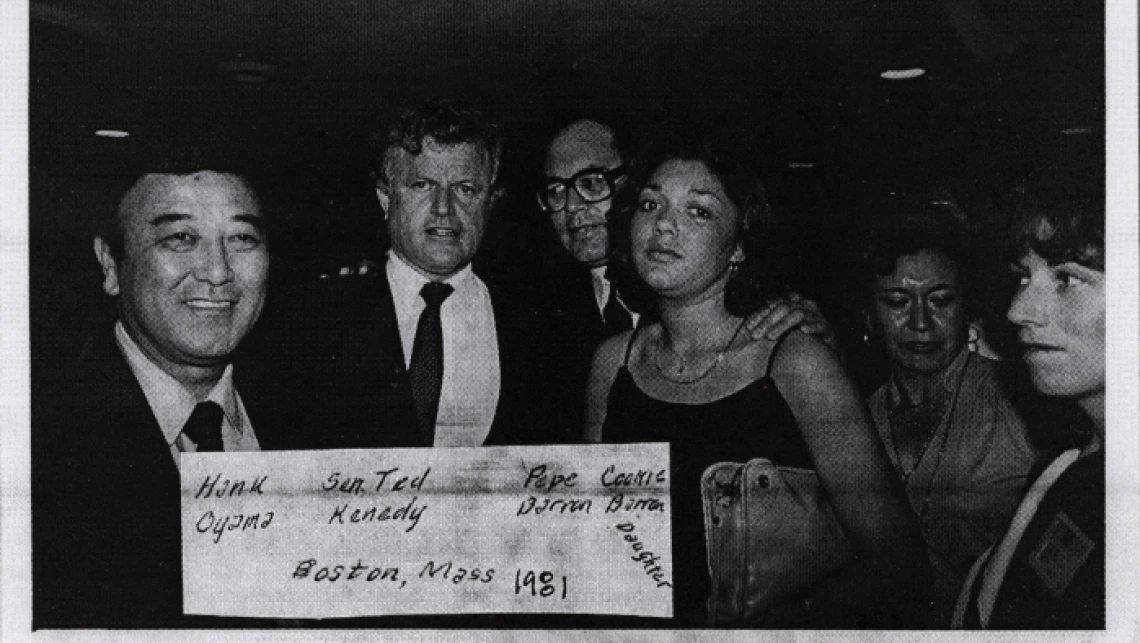Henry “Hank” Oyama papers

Photocopy of a photograph of Hank Oyama posing with Senator Ted Kennedy and Others, 1981.
Collection area: Arizona and Southwest
Collection dates: 1943-2003 bulk (bulk 1973-1980; 1991-2002)
This collection contains correspondence; reports; files related to conferences and events; journal and newspaper articles; and publications. The time period represented in the collection is 1945-2003, but the bulk of the items are from 1973-1980 and 1991-2002. Most materials relate to Henry “Hank” Oyama’s involvement in the bilingual education movement in the Tucson area as well as his work for general Mexican-American rights. Reports and research for the reports make up the largest series in the collection. The reports are from all over the United States and relate to bilingual education and Hispanic issues. Of note in this series are Oyama’s handwritten notes referring to some of these reports. There is also a large amount of material dedicated to the English Only/English Plus More debates of the 1990s in Arizona.
Henry “Hank” Oyama was born in 1926 and grew up in Mexico. He is of Japanese descent, and his first language is Spanish. His father died before he was born, and he was raised by his mother and maternal grandfather in Nogales. When his grandfather passed away, he and his mother moved to Tucson where they lived until the Japanese bombed Pearl Harbor in 1941. Oyama was fifteen years old at this time, and he and his mother were interned in concentration camps along with thousands of other Japanese and Japanese Americans. After the release of the internees, Oyama and his mother moved to Excelsior Springs, MO. Upon graduation from high school, he enlisted in the U.S. Army, and he was assigned to the Panama Canal Zone because his first language was Spanish.
In 1947, Oyama left the army and returned to civilian life where he earned a BA and MA in Education from the University of Arizona. Throughout college he worked for Tucson Newspapers, Inc. In 1952, he began his teaching career at Safford Junior High School in Tucson. Three years later, Oyama began his efforts in bilingual education when he was selected as a faculty member at the brand new Pueblo High School. At Pueblo, Oyama designed and executed a plan to teach both Spanish and English to native Spanish speakers. Through this program, he became involved with two U.S. senators who introduced national legislation to provide funding for bilingual education. At the age of 33, Oyama fell in love with Mary Ann Jordan. However, there was still a law in effect that banned marriage between Asians and Caucasians. After taking their battle to court, the two were married in 1959. Their first child died of leukemia, and they went on to adopt four children. They were married until Mary Ann’s death from heart failure in 1987 at the age of 55.
In 1970, he left Pueblo High School and began working for the Bilingual and International Studies at Pima Community College, becoming the dean of that program in 1978. He retired after 22 years at Pima Community College.
A collection guide explains what's in a collection. New to using our collections? Learn how to use a collection guide.
Collection guideAccess this collection
Visit us in person to access materials from this collection. Our materials are one-of-a-kind and require special care, so they can’t be checked out or taken home.
How to cite
Learn how to cite and use materials from Special Collections in your research.
